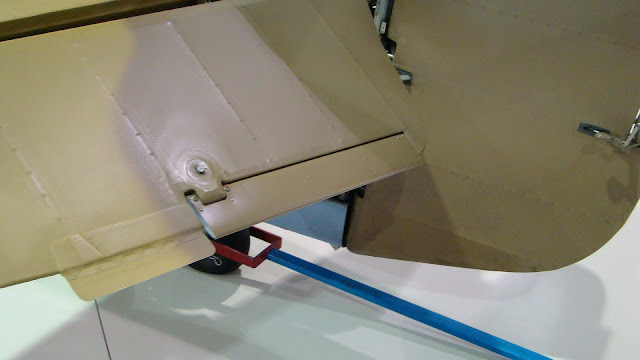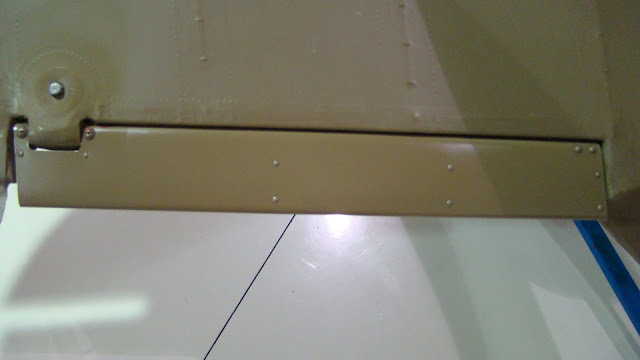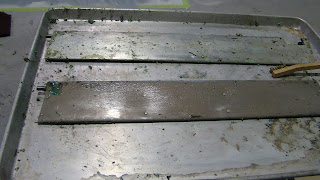A little while more with the trim tabs,
Two Saturday's ago I finally made my way back to the Hurricane. The task I undertook was a bit simpler than the compression test from a few weeks back, but equally important. This task involved removing, and preparing for painting, the elevator trim tabs.
 |
| Trim tab on the left elevator of the Flight Lieutenant Bunny McLarty Hurricane IV – the world's only flying Mark IV |
Now before I took a picture of the task I was assigned, I had already removed the tabs on the Mk. XII. However, seeing as they are exactly the same on the MK IV, a picture of the tabs on the MK IV will serve nicely for showing where I began.
 |
| Close up of trim tab on Hurricane IV elevator. |
|
|
Interestingly enough, removing the trim tab is not as complicated as it looks. Well to take only the tab itself isn’t all that troublesome. It is merely held in place by two bolts and two nuts. If you wanted to service the chains and pulleys that operate it, then you’d have a job on your hands. The chain, cables, and pulleys are concealed underneath the fabric. To get at them would be quite the pain in the arse. However, luckily for us, the Mk. XII isn’t fabric covered yet.
 |
| The starboard elevator trim tab location on the exposed structure of the Flying Officer Willie McKnight Hurricane XII |
Pictured above, the starboard elevator trim tab has been removed. On the right hand side, where the dark green paint is, is the control for the entire tab and where it is bolted in place. On the opposite side, there is a hole for a pin (which is attached to the tab itself). But back to the right-hand side of the photo, if you look a little past, you’ll see a box and a chain running towards the nose from the box. That chain then goes around another pulley and connects to the trim cables which then runs into the fuselage and up to the cockpit.
 |
| The attachment point and control linkage point for the starboard elevator trim tab |
That aside, there is only a very small mechanism that actually moves and activates the tab. The piece you can see the bolt going through in the picture above rotates when the trim is adjusted from the cockpit. As the back end is a pin, the tab rotates up and down with ease. To better illustrate, see the picture of the removed tab below:
 |
| Trim tabs are ready for paint prep. |
Now you can clearly see the pin end and the U-shaped end that attaches to the rotating/adjusting mechanism. Now it was time to prepare the tabs for a repaint. After using scotch-brite to scuff up the current paint job to allow the paint stripper to penetrate, it was time to bust out the chemicals.


Tal-Strip II. So powerful it can clean off a Boeing Globemaster with just one bottle…well I suppose that might be a bit of a grandiose claim, but it’s one way to market otherwise normal paint stripper. In the second picture you will note its’ turquoise colour, its’ jelly like texture and appearance, and its despicable smell/odour…or perhaps that last one’s just me. Also, stripping various aircraft parts is a task apprentices will often do when they get hired. I now see why, though I quite enjoyed it because I was working on a Hurricane, I can see it as being a less-than-desirable task. Nonetheless, for our restoration and any other project, protecting parts against corrosion is important and our Hurricane could use a new coat of paint.
Due to the fact that I had pre-scuffed the paint, when the stripper was applied, it was able to “get underneath” and “lift” the old paint off. It was then just a matter of wiping and scraping it off. Then once that was done, the pieces were rinsed with water (because water neutralizes the acidic paint-stripper), tagged, and placed on the shelf to await painting. I will show a picture next week or whenever they are given a fresh coat of paint to show the difference.

Some of the other tasks that were completed/worked on, of which I didn’t get a picture, included making some new gaskets to protect some of the flight controls when they pass through a firewall, installation and running of the elevator trim cables, inspection of the wings and aileron cables, and cleaning out of the alternator and generator and preparing them for installation.
That’ll have to bring this week’s session to a conclusion, I apologize for such a short one, but I suppose only so much can be said about stripping paint and we’ve already had a lesson in trim tabs.
Looking forward to next week, until then, take care!
Chris Eaton, the Bloggin' Vintage Winger

No comments:
Post a Comment